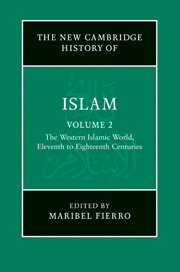Book contents
- Frontmatter
- Introduction
- PART I AL-ANDALUS AND NORTH AND WEST AFRICA (ELEVENTH TO FIFTEENTH CENTURIES)
- PART II EGYPT AND SYRIA (ELEVENTH CENTURY UNTIL THE OTTOMAN CONQUEST)
- PART III MUSLIM ANATOLIA AND THE OTTOMAN EMPIRE
- PART IV NORTH AND WEST AFRICA (SIXTEENTH TO EIGHTEENTH CENTURIES)
- PART V RULERS, SOLDIERS, PEASANTS, SCHOLARS AND TRADERS
- 19 State formation and organisation
- 20 Conversion to Islam: from the ‘age of conversions’ to the millet system
- 21 Taxation and armies
- 22 Trade
- 23 The ʿulamāʾ
- Glossary
- Bibliography
- Index
- References
20 - Conversion to Islam: from the ‘age of conversions’ to the millet system
from PART V - RULERS, SOLDIERS, PEASANTS, SCHOLARS AND TRADERS
Published online by Cambridge University Press: 28 March 2011
- Frontmatter
- Introduction
- PART I AL-ANDALUS AND NORTH AND WEST AFRICA (ELEVENTH TO FIFTEENTH CENTURIES)
- PART II EGYPT AND SYRIA (ELEVENTH CENTURY UNTIL THE OTTOMAN CONQUEST)
- PART III MUSLIM ANATOLIA AND THE OTTOMAN EMPIRE
- PART IV NORTH AND WEST AFRICA (SIXTEENTH TO EIGHTEENTH CENTURIES)
- PART V RULERS, SOLDIERS, PEASANTS, SCHOLARS AND TRADERS
- 19 State formation and organisation
- 20 Conversion to Islam: from the ‘age of conversions’ to the millet system
- 21 Taxation and armies
- 22 Trade
- 23 The ʿulamāʾ
- Glossary
- Bibliography
- Index
- References
Summary
The process of conversion
At the beginning of the fifth/eleventh century the majority of the people living in the territories under Muslim rule were themselves Muslim. What has been called ‘the age of conversions’, a period which we now believe encompassed the first three centuries of Islam at the very least, was coming to a close. The traditional interpretation of Islamic history maintained that conversion to Islam took place on a massive scale during the great wave of conquests that took place over the roughly 100 years following the Prophet Muḥammad’s death. However, since the 1960s, scholars of diverse aspects of the early Islamic world have provided the basis for a reinterpretation of the sources. The result is a new consensus that this ‘age of conversions’ was somewhat longer than previously thought. In most areas, it appears that the rate of conversion to Islam showed its steepest growth in the late third/ninth century and the fourth/tenth, and in some regions, such as al-Andalus, the process of conversion continued into the beginning of the sixth/twelfth century. There has been a more limited interest in the study of conversion processes that occurred after the initial large-scale phenomenon; this does not mean that in the late medieval and early modern centuries waves of mass conversion to Islam did not take place.
- Type
- Chapter
- Information
- The New Cambridge History of Islam , pp. 586 - 606Publisher: Cambridge University PressPrint publication year: 2010
References
- 1
- Cited by



